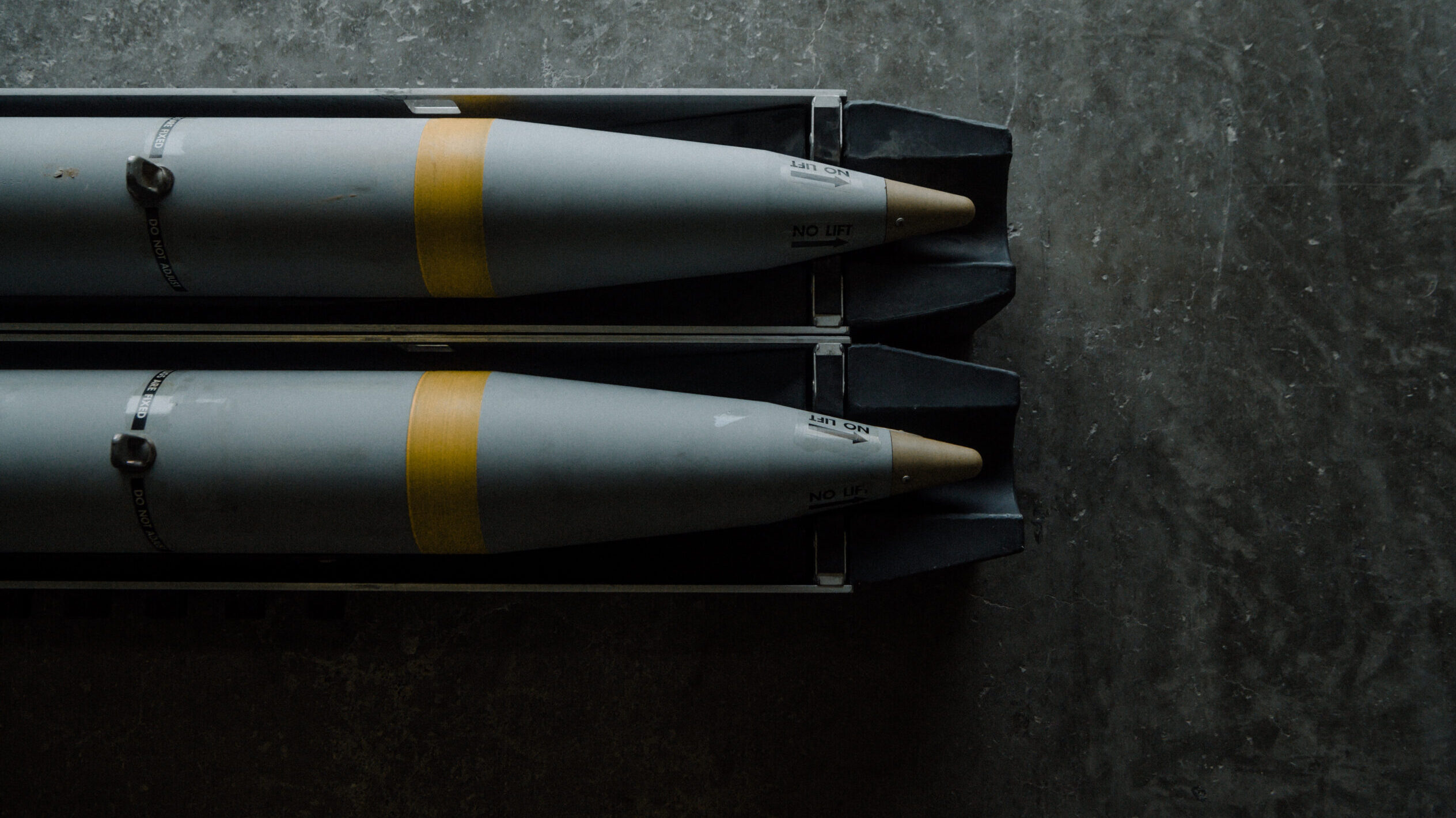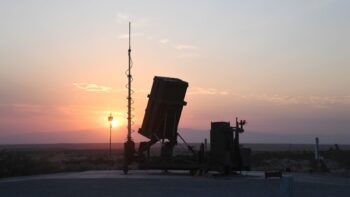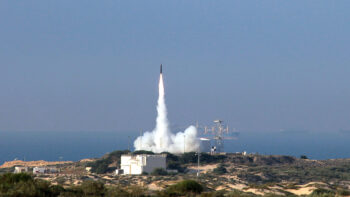
Two GBU-39 small diameter bombs sit in the munitions storage area at Al Udeid Air Base, Qatar, Nov. 27, 2020. (U.S. Air National Guard photo by Staff Sgt. Jordan Martin)
With the White House expected to announce the release of a Patriot battery for Ukraine’s use, there is once again a debate raging in Washington about what new equipment can, or should, be sent to Kyiv’s aid. In the following op-ed, John Hardie and Bradley Bowman argue that there is another capability the Biden administration should clear for Ukraine’s defense — a fairly cheap weapon with a long-range to strike at Russian targets.
The Kremlin on Dec. 13 rejected a Ukrainian peace proposal that called for Russia to withdraw its troops from Ukraine, instead insisting that Kyiv should simply accept the “new realities” and cede its occupied territories to Moscow. It’s a clear sign from Moscow: they’re not interested in this war ending anytime soon. To help Ukraine defeat Russia’s invasion and liberate its land and people, Washington needs to redouble efforts to provide Ukrainians with the weapons they need.
One way to do that, which is apparently now under consideration, is sending Kyiv the Ground-Launched Small Diameter Bomb (GLSDB). This system, which integrates an existing munition and rocket at a relatively low cost, would enable the Ukrainian military to strike high-value Russian targets well beyond the range of current Western-supplied munitions. That would help Ukrainian forces further degrade Russian logistics and command and control and ultimately retake more territory. For this reason, the Pentagon should move without delay to provide Kyiv with the GLSDB.
A joint project by Saab and Boeing, the GLSDB marries two affordable, combat-proven systems: the GBU-39 Small Diameter Bomb, a 113 kg precision-guided munition that is relatively cheap at around $40,000 each, and the M26, a low-cost, formerly demilitarized rocket. The system could include a multi-purpose warhead tailored for fixed, hardened, low collateral damage, and moving targets.
The GLSDB would allow Ukrainian forces to strike Russian military targets up to 150 km away with an accuracy of around one meter. With integration, the GLSDB can be fired by the M142 HIMARS and M270 MLRS rocket artillery systems already supplied to Ukraine by the United States and United Kingdom, respectively.
But it can also be fired by non-traditional launchers, such as from the back of an ordinary-looking truck or from a nondescript shipping container hidden in plain sight. That would make it more difficult for Russian forces to find and destroy the system. The non-traditional launcher also makes the system a low-cost option to augment HIMARS, which US industry is currently racing to produce in order to both replace US launchers sent to Ukraine and meet demand from allies.
One of the great advantages of the GLSDB is that the munition and rocket already exist in the US arsenal. Industry would only need to integrate the munition and rocket rather than undertaking the time-consuming process of establishing a new production line. Accordingly, depending on several factors, Ukraine could receive an initial delivery of two launchers and 24 weapons in as little as nine months after the Pentagon approves the plan. If industry and the Pentagon move with a sense of urgency and Congress provides assertive oversight, a decision now by the Department of Defense could see an estimated 750 GLSDBs and 12 launchers delivered to Ukraine by the end of 2024. That dramatic ramp up in production is possible because industry simply needs to integrate existing bombs and rockets rather than build new ones.
That’s the how. Here’s the why: Providing the GLSDB would enhance Ukraine’s ability to weaken Russian forces by hitting high-value targets deep behind the front lines.
Ukraine has employed this strategy to great effect since it received its M142 and M270 systems over the summer, striking key bridges, ammunition and fuel depots, command-and-control nodes, and other high-value targets in Russia’s rear. This has helped Ukraine halt Russia’s advances and played a critical role in Ukraine’s successful counteroffensives in Kharkiv and Kherson oblasts.
But whereas the Guided Multiple Launch Rocket System, or GMLRS, rockets provided for Ukraine’s M142 and M270 systems can hit targets from around 85 kilometers away, the GLSDB would enable the Ukrainian military to strike targets at almost double that range. For example, the key Russian logistics hub in Luhansk city and its environs, just out of reach of GMLRS, would be well within the GLSDB’s range. The same goes for the critical rail hub in the Crimean city of Dzhankoi, which supplies Russia’s grouping in southern Ukraine. Nearby settlements house major vehicle parks ripe for targeting.
If Ukraine had the GLSDB, Russia would be forced to move its depots even farther back from the front line, making it more difficult for Russian logistics to provide combat units with sufficient ammunition and other supplies to hold back Ukrainian forces, let alone take ground themselves. Likewise, Ukraine could strike various airbases from which Russian aircraft provide close air support to Russian troops or launch missiles targeting Ukraine’s critical infrastructure. GLSDB would also help Kyiv target bases in Ukraine from which Russian forces are launching Iranian drones.
Indeed, the best form of air and missile defense includes an offensive strike capability.
The GLSDB could fulfill some of the missions that would be assigned to ATACMS missiles, which are also fired by the M142 and M270 but have a 300-kilometer range. For months, Kyiv has pleaded for ATACMS. But the White House has refused, fearing that providing these missiles could invite further provocation from Russian President Vladimir Putin.
This risk is overstated when it comes to ATACMS, and the Biden administration should not let similar fears deter it from sending the GLSDB. Thus far, Moscow’s reaction to the West’s provision of military aid to Kyiv has featured lots of bark but little bite. Western materiel has enabled Ukraine to stay in the fight and eventually retake large swathes of land, including Ukrainian territory Putin has cynically labeled as part of Russia.
While Moscow has escalated attacks in Ukraine, the Kremlin has assiduously avoided attacking any NATO member, despite the Western weapons flowing into Ukraine. There’s little doubt why: Doing so would risk a direct conflict with the United States, something Putin appears keen to avoid, particularly when the bulk of his military is tied down in Ukraine — and badly battered.
As an extra precaution, the Biden administration could condition its provision of the GLSDB on a Ukrainian commitment to use the system only against targets in occupied Ukrainian territory, including Crimea. Kyiv has honored a similar promise made with respect to HIMARS, and there’s every reason to believe the Ukrainians would keep their word with the GLSDB.
The Kremlin wants Kyiv and the West to accept “new realities” in Ukraine following Russia’s unprovoked invasion. That would be a disaster, inviting more aggression in the future from authoritarian regimes seeking to bully beleaguered democracies and seize territory by force.
In Ukraine, the United States has a partner willing to fight for our shared interests and principles. They aren’t asking Americans to do the fighting for them. They are simply asking for the means to defend their homes.
The GLSDB would provide Ukraine with a powerful tool to advance US and Ukrainian interests. Every day the Pentagon delays its decision on the GLSDB is another day Ukraine will go without this valuable capability. There is no time to waste.
John Hardie is deputy director of the Russia Program at the Foundation for Defense of Democracies (FDD), where Bradley Bowman is senior director of FDD’s Center on Military and Political Power.
Israel likely partner for Greece as it looks for integrated air defense systems
A pair of sources told Breaking Defense that Greece is in the fact-finding process of what systems Israeli might be willing to sell, as Athens looks for multi-layered air defense options.



























